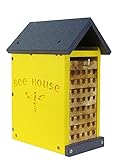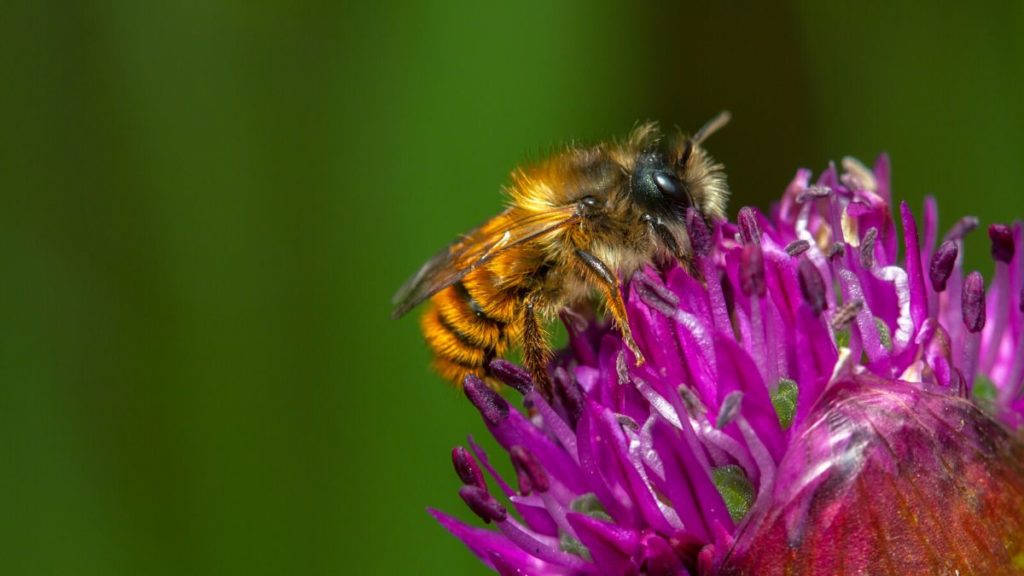
Mason bees are so named because they use mud to construct a nest much like a mason uses mortar for building. While Mason bees do, as other bees, gather pollen and nectar to feed their larvae, they have many distinct characteristics that make them important in the garden and amazing in the insect world.
We will look at how to attract Mason bees to your garden and yard, but it’s first important to understand these amazing insects so you know what you’re dealing with.
The Bee Family
When the word ‘bee’ is used, most of the time we think of the honeybee. Mason bees and honeybees are related, certainly. Mason bees are in the Family Megachilidae along with leafcutter bees. They are cousins, if you will, of honeybees which are in the Family Apidae. While there are a few characteristics they share generally as “bees” such as gathering pollen, there are many more differences.
Thinking back to your days in biology class, you may remember animals are in the animal kingdom, or more precisely Kingdom Animalia. The classification of animals puts similar animals in categories or levels, and as you move down the list, the commonalities fall away as you get to the specific types of animals known as “species”.
So, in case you want to impress your friends at your next trivia night, the classification of bees in general goes as follows:
- Kingdom – Animalia
- Phylum – Arthropoda
- Class – Insecta
- Order – Hymenoptera
In the Hymenoptera Order, you find all the bees, wasps, hornets, and even ants. The next level down are Families and this is where our mason bees start to differ from honeybees. Mason bees are in the Family Megachilidae while honeybees are in the Family Apidae. This Family name and the word ‘apiary’ are both derived from the Latin apiarium meaning bee house.
Below the Family level, one begins grouping animals by Genus and Species. Mason bees are all in the Genus Osmia and the different kinds of mason bees are then further classified by species. There are 140 native mason bee species in North America, as well as a few introduced varieties from Europe. Due to their life cycle and excellent habit of pollinating fruit trees in spring, they are often also referred to as orchard mason bees.
Do Mason Bees Sting?
The best answer to this question is yes, and no. Female mason bees are capable of stinging, but they are not as aggressive as other types of bees. Since they are not in the habit of defending a queen or hive, they don’t have the same need to sting in defense.
Generally, they are pretty focused on their daily chores of gathering food and building a nest and are not likely to sting. This is one difference between honeybees and mason bees, but there are many more.
5 Ways Mason Bees Differ from Honeybees
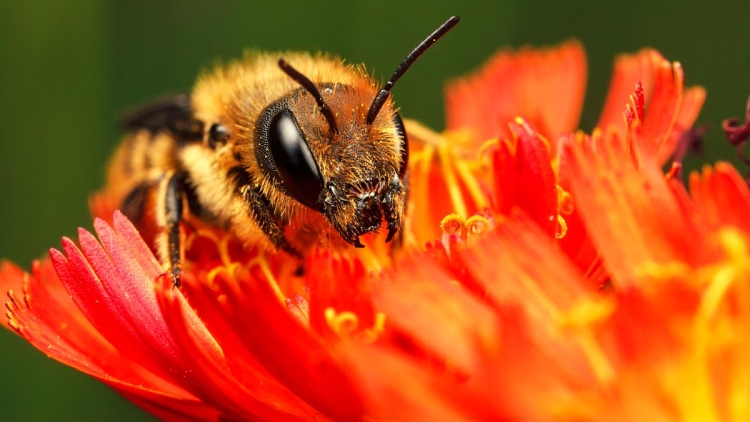
Appearance
For starters, mason bees tend to be smaller (between ¼ and ¾ of an inch) and bluish black in color. Honeybees are usually around ¾ of an inch and have the familiar bands on their bodies of gold or yellow and black or brown.
When you see them both in the garden, honeybees will be holding the yellow-colored pollen on their hind legs. Mason bees, by contrast, have special hairs on their abdomen that allow them to pick up pollen efficiently, and appear more covered with pollen.
Living Quarters
While honeybees are communal, creating a hive with a queen in which the workers care for them all, mason bees are solitary. A female mason bee will construct her own nest and care for her own young, even if she does decide to take up residency near other mason bees.
Work Life
As far as pollination goes, mason bees are considered better than honeybees. A solitary mason bee can pollinate the same number of blossoms as 120 honeybees. That is a busy bee. While honeybees will travel quite far to find sources of nectar, mason bees are all about the local source for their food, foraging in a very small area near where they nest.
As mentioned above, their method of collecting pollen is also different. There are parallel rows of special hairs, called scopa, on the abdomen of female mason bees. Males do not have these hairs as their lives are short, as you’ll read later on.
The hairs grab or suck up pollen from the flower the mason bee is on, and pollen also falls off the hairs pollinating nearly every flower they visit. This is contrasted with honeybees that gather and stick pollen in baskets on their hind legs.
Productivity
Honeybees are of course known for producing honey. The pollen and nectar they gather is used to fill cells in the hive as food stores mainly to help the hive overwinter.
Since mason bees don’t maintain a collective hive, they don’t need to produce honey for a colony. However, mason bees simply, and very efficiently, pollinate important early-blooming food crops. Many orchardists maintain nests and encourage and care for mason bees because they are critical to the production of many of the fruits we eat.
- Hunter, Dave (Author)
- English (Publication Language)
Longevity
However, another difference is lifespan. Solitary female mason bees live about four to six weeks in spring. In that time, her focus is building a nest and collecting food to support her eggs. More on that bit of architecture later.
The timing of her life and busy time means she is only able to pollinate those plants blooming at that time. In many cases, these are members of the Rosaceae family such as apples, plums, pears and the like.
Individual honeybees, aside from the queen, are shorter-lived in summer and a bit longer-lived in winter. The difference is as a communal hive continuing to produce more members, we see them all summer long as different generations from the hive. In summer, honeybees are busy and vulnerable outside of the hive but in winter live off the stored honey.
Mason Bee Life Cycle
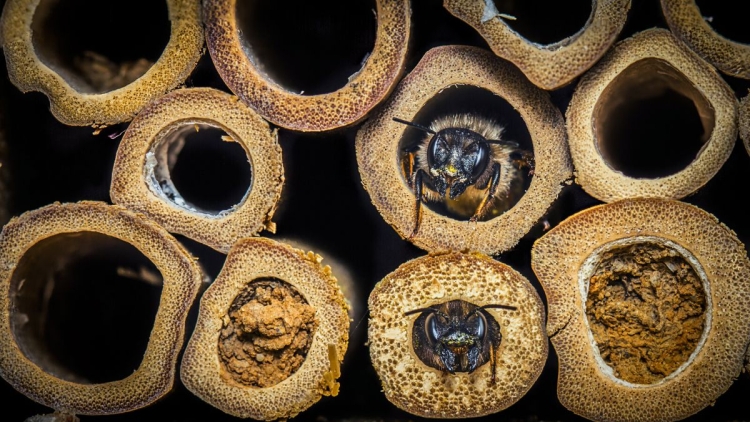
In early spring when the daytime temperatures reach the mid-50s Fahrenheit, eggs from the front of the tube or nest begin to hatch. These are male mason bees. They emerge and begin visiting flowers for food – a combination of nectar and pollen.
Pollen are the fine grains on male flower parts that need to be transferred to the female flower parts in order to result in fruit and seeds. Nectar is the sweet, liquid substance plants use to attract pollinators to their flowers in order to get some help in this transfer by the animal kingdom.
Pollen provides primarily protein and fat while nectar offers up sugars, oils, and other nutrients (source). Bees use these individually and together to feed themselves and their larvae.
But I digress, back to the male mason bees. After emerging, they wait for the females to emerge which can take a few days to a week. As soon as the females emerge, they mate, and the males soon die. The female is then on her own from here.
Why are they called Mason Bees?
Mason bees use mud much like masons use mortar, to build structures, hence the “mason” in their name. The female mason bee finds a suitable site for a nest which can be a narrow cavity in a tree or a tube in a man-made bee house. It is typically also near flowering plants and also a wet area where there is mud. The female mason bee will collect the mud to seal up the very back end of the nest cavity.
With the back wall of her first cell built, she collects both pollen and nectar which she deposits in this first space as provision for her first egg. She fertilizes the egg she lays to ensure it will be a female and then collects mud to seal the cell. With one down, there are typically four to five more to go in that cavity.
Typically, the back two to three cells are females, and the remaining front cells are males, which are eggs she does not fertilize. One reason for this is that the females are safer from predation being further back in the nest. Also, the males are the ones that emerge first, so that they are around and waiting to mate with females.
They chew through the mud plugs, opening up a pathway for the females further back to easily come through. Pretty brilliant.
Once a female mason bee has created a series of between five and eight cells, each containing an egg and food, she again uses mud to create an especially thick plug. She then moves on to find another suitable nest site and begins again. Female mason bees will create around four nests before they die which can be sometime in June.
The eggs inside each cell hatch and consume the nectar and pollen stores left by their mother bee. This gives them the energy to move through larval stages, spin a cocoon and pupate in fall. They stay safely in their nest cell until the next spring when it is time to emerge.
How to Attract Mason Bees to your Garden
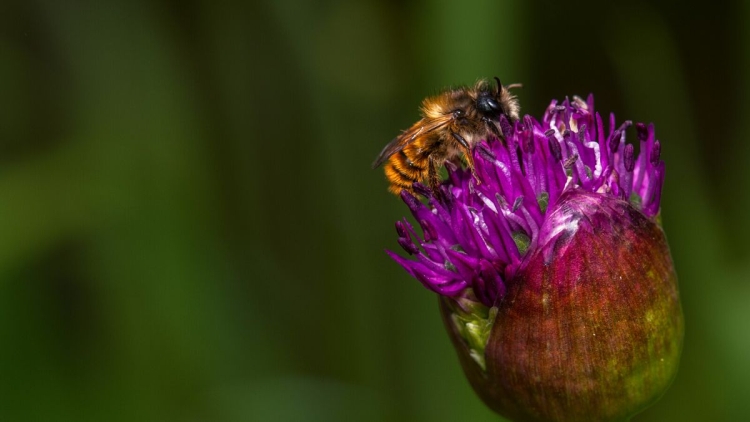
There are numerous species of mason bees all over North America. If you observe your flowers carefully in spring, you will likely see mason bees working tirelessly visiting blossoms. If you want to help nature along by trying to make your area more hospitable, there are things you can do to attract mason bees.
Bee Houses
As many orchardists have learned, installing suitable nesting materials will bring mason bees in. Due to their habit of foraging near their nest, if you lay out the red carpet your early blooming plants will benefit.
There are a few different types of bee houses available. Some have tubes made of paper or cardboard that need to be replaced each year after all the bees have emerged. Other designs feature blocks of wood with grooves in them that, when stacked, give the appearance of tubes.
For those that will be involved in checking on and even harvesting the larvae for better overwinter protection, it may be easier to use the wood blocks. They provide easy access to the cells not only for collecting but to check on the health and condition of the brood.
- MULTI-TIERED: 8 Removable Routed Charred Pine Panels
- EASY TO USE: Easy to Remove Locking Block
- Mason Bee Box Main Purpose - Bee Houses for the Garden Mason Bee Houses Size: 8" x 8" x 4" / 20cm*20cm*10.5cm and 2.6 lbs/1.2kg.Sturdy Mason Bee Hotel attract and protect mason bees, butterflies and ladybugs to live in your garden, making your garden more productive, and It can also contribute to preventing carpenter bees from causing damage to your house.
- Bee Hotel for the Garden - Delux Hexagon Bee Houses are made of solid pine wood.Mason Bee Hotel - Naturally dry bamboo tubes will not be moldy and pollinators will not get sick easily.
Place the bee house so the tubes or channels are horizontal. A location with a bit of shelter is good to protect the nest from bad weather and also offer a bit of shelter in the middle of summer when larvae are hatching in the tubes. Mason bees do need some sun, ideally morning sun, so an east facing site would be ideal. The bee house should also be high enough to be out of reach of pets and children.
Do you need to clean out Mason Bee houses?
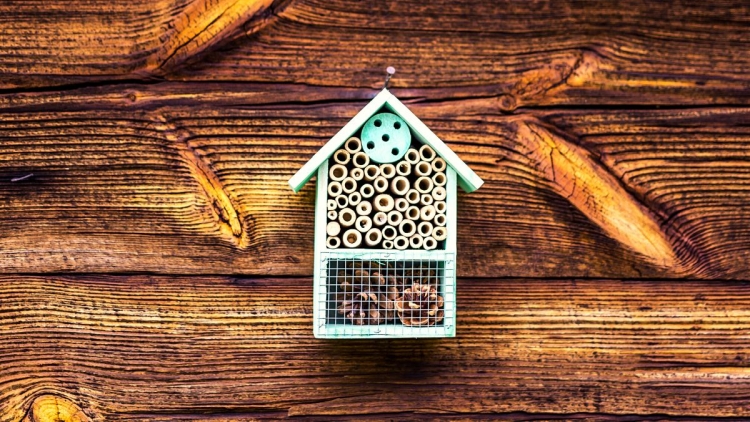
If you do decide to nurture mason bees in your garden, be sure to learn more about how to care for them over the winter. While it isn’t required that you clean out mason bee houses, it will help the next generation survive next spring.
Those left outside in their houses are vulnerable to a variety of hazards. Pollen mites are a problem, especially in damp and moist environments. They ride the bees as a means to travel to eat pollen and can come back into the nest on the female. If they colonize an egg cell, they will eat the pollen stores left for the new bee and sometimes even the bee larva.
Mold can also be an issue when there is excessive moisture. Placement of bee houses under shelter to keep them out of the rain can help with these issues.
Parasitic wasps, beetles, and some birds can all prey on the nests of mason bees. To minimize the potential for losing some of all of your mason bees to predators, you can choose to bring them inside.
It is recommended you place the tubes in a cool, dry place in the basement or in the refrigerator. The goal is to keep the temperatures consistently below 50 degrees, but not freeze them, so they are not triggered to emerge and remain alive.
Once the weather warms and your place your bees outside, they will emerge gradually. As soon as they are out, you can clean away any debris in the tubes or channels of your bee house so it is ready for a new female bee.
Install Early Blooming Plants
Mason bees get started early in the warming season when temperatures stay in the mid 50s. This is also the time when many fruit trees blossom. For this reason, apples, pears, crabapples, cherries, and other fruit trees are excellent sources of food for mason bees. In return, they will populate the flowers like crazy and you will enjoy a big crop of fruit.
Early blooming herbaceous and woody shrubs are also sources of pollen and nectar. We suggest checking with your local extension service for the best advice on native plants to use. Please be aware that some early blooming plants readily available in garden centers can be invasive, such as purple loosestrife and Japanese honeysuckle, and crowd out valuable natives.
In general, plants such as elderberry, currants, forget-me-nots, and lupine bloom early and will attract mason bees.

Summing up the Powerhouses of Pollination
While mason bees are a seasonal bee with a short life, they make up for that in their efficiency in pollinating a small area around their nest. Without a hive to defend, these solitary bees are less aggressive and far less likely to sting. You can encourage their presence in your garden in spring by hanging bee houses and planting native, early blooming plants.


